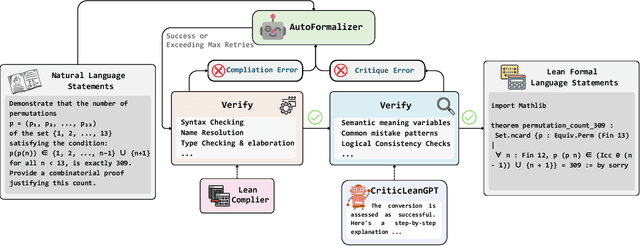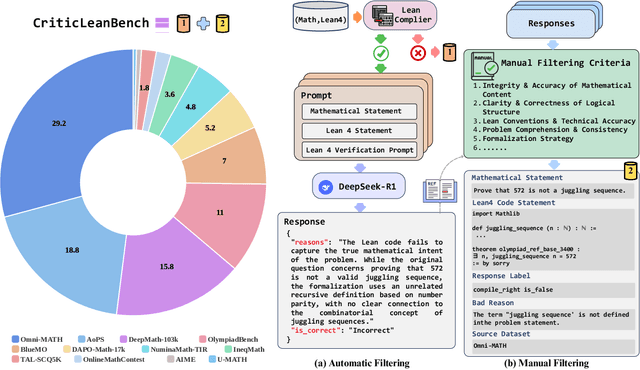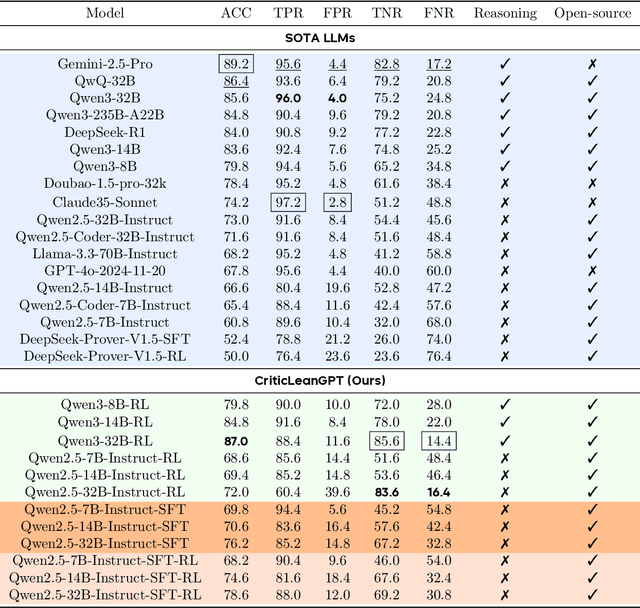Minghao Liu
Lean4Physics: Comprehensive Reasoning Framework for College-level Physics in Lean4
Oct 30, 2025Abstract:We present **Lean4PHYS**, a comprehensive reasoning framework for college-level physics problems in Lean4. **Lean4PHYS** includes *LeanPhysBench*, a college-level benchmark for formal physics reasoning in Lean4, which contains 200 hand-crafted and peer-reviewed statements derived from university textbooks and physics competition problems. To establish a solid foundation for formal reasoning in physics, we also introduce *PhysLib*, a community-driven repository containing fundamental unit systems and theorems essential for formal physics reasoning. Based on the benchmark and Lean4 repository we composed in **Lean4PHYS**, we report baseline results using major expert Math Lean4 provers and state-of-the-art closed-source models, with the best performance of DeepSeek-Prover-V2-7B achieving only 16% and Claude-Sonnet-4 achieving 35%. We also conduct a detailed analysis showing that our *PhysLib* can achieve an average improvement of 11.75% in model performance. This demonstrates the challenging nature of our *LeanPhysBench* and the effectiveness of *PhysLib*. To the best of our knowledge, this is the first study to provide a physics benchmark in Lean4.
GUI-ReWalk: Massive Data Generation for GUI Agent via Stochastic Exploration and Intent-Aware Reasoning
Sep 19, 2025Abstract:Graphical User Interface (GUI) Agents, powered by large language and vision-language models, hold promise for enabling end-to-end automation in digital environments. However, their progress is fundamentally constrained by the scarcity of scalable, high-quality trajectory data. Existing data collection strategies either rely on costly and inconsistent manual annotations or on synthetic generation methods that trade off between diversity and meaningful task coverage. To bridge this gap, we present GUI-ReWalk: a reasoning-enhanced, multi-stage framework for synthesizing realistic and diverse GUI trajectories. GUI-ReWalk begins with a stochastic exploration phase that emulates human trial-and-error behaviors, and progressively transitions into a reasoning-guided phase where inferred goals drive coherent and purposeful interactions. Moreover, it supports multi-stride task generation, enabling the construction of long-horizon workflows across multiple applications. By combining randomness for diversity with goal-aware reasoning for structure, GUI-ReWalk produces data that better reflects the intent-aware, adaptive nature of human-computer interaction. We further train Qwen2.5-VL-7B on the GUI-ReWalk dataset and evaluate it across multiple benchmarks, including Screenspot-Pro, OSWorld-G, UI-Vision, AndroidControl, and GUI-Odyssey. Results demonstrate that GUI-ReWalk enables superior coverage of diverse interaction flows, higher trajectory entropy, and more realistic user intent. These findings establish GUI-ReWalk as a scalable and data-efficient framework for advancing GUI agent research and enabling robust real-world automation.
CriticLean: Critic-Guided Reinforcement Learning for Mathematical Formalization
Jul 08, 2025



Abstract:Translating natural language mathematical statements into formal, executable code is a fundamental challenge in automated theorem proving. While prior work has focused on generation and compilation success, little attention has been paid to the critic phase-the evaluation of whether generated formalizations truly capture the semantic intent of the original problem. In this paper, we introduce CriticLean, a novel critic-guided reinforcement learning framework that elevates the role of the critic from a passive validator to an active learning component. Specifically, first, we propose the CriticLeanGPT, trained via supervised fine-tuning and reinforcement learning, to rigorously assess the semantic fidelity of Lean 4 formalizations. Then, we introduce CriticLeanBench, a benchmark designed to measure models' ability to distinguish semantically correct from incorrect formalizations, and demonstrate that our trained CriticLeanGPT models can significantly outperform strong open- and closed-source baselines. Building on the CriticLean framework, we construct FineLeanCorpus, a dataset comprising over 285K problems that exhibits rich domain diversity, broad difficulty coverage, and high correctness based on human evaluation. Overall, our findings highlight that optimizing the critic phase is essential for producing reliable formalizations, and we hope our CriticLean will provide valuable insights for future advances in formal mathematical reasoning.
What Matters in LLM-generated Data: Diversity and Its Effect on Model Fine-Tuning
Jun 24, 2025Abstract:With the remarkable generative capabilities of large language models (LLMs), using LLM-generated data to train downstream models has emerged as a promising approach to mitigate data scarcity in specific domains and reduce time-consuming annotations. However, recent studies have highlighted a critical issue: iterative training on self-generated data results in model collapse, where model performance degrades over time. Despite extensive research on the implications of LLM-generated data, these works often neglect the importance of data diversity, a key factor in data quality. In this work, we aim to understand the implications of the diversity of LLM-generated data on downstream model performance. Specifically, we explore how varying levels of diversity in LLM-generated data affect downstream model performance. Additionally, we investigate the performance of models trained on data that mixes different proportions of LLM-generated data, which we refer to as synthetic data. Our experimental results show that, with minimal distribution shift, moderately diverse LLM-generated data can enhance model performance in scenarios with insufficient labeled data, whereas highly diverse generated data has a negative impact. We hope our empirical findings will offer valuable guidance for future studies on LLMs as data generators.
Scaling Test-time Compute for LLM Agents
Jun 15, 2025Abstract:Scaling test time compute has shown remarkable success in improving the reasoning abilities of large language models (LLMs). In this work, we conduct the first systematic exploration of applying test-time scaling methods to language agents and investigate the extent to which it improves their effectiveness. Specifically, we explore different test-time scaling strategies, including: (1) parallel sampling algorithms; (2) sequential revision strategies; (3) verifiers and merging methods; (4)strategies for diversifying rollouts.We carefully analyze and ablate the impact of different design strategies on applying test-time scaling on language agents, and have follow findings: 1. Scaling test time compute could improve the performance of agents. 2. Knowing when to reflect is important for agents. 3. Among different verification and result merging approaches, the list-wise method performs best. 4. Increasing diversified rollouts exerts a positive effect on the agent's task performance.
GenIR: Generative Visual Feedback for Mental Image Retrieval
Jun 06, 2025Abstract:Vision-language models (VLMs) have shown strong performance on text-to-image retrieval benchmarks. However, bridging this success to real-world applications remains a challenge. In practice, human search behavior is rarely a one-shot action. Instead, it is often a multi-round process guided by clues in mind, that is, a mental image ranging from vague recollections to vivid mental representations of the target image. Motivated by this gap, we study the task of Mental Image Retrieval (MIR), which targets the realistic yet underexplored setting where users refine their search for a mentally envisioned image through multi-round interactions with an image search engine. Central to successful interactive retrieval is the capability of machines to provide users with clear, actionable feedback; however, existing methods rely on indirect or abstract verbal feedback, which can be ambiguous, misleading, or ineffective for users to refine the query. To overcome this, we propose GenIR, a generative multi-round retrieval paradigm leveraging diffusion-based image generation to explicitly reify the AI system's understanding at each round. These synthetic visual representations provide clear, interpretable feedback, enabling users to refine their queries intuitively and effectively. We further introduce a fully automated pipeline to generate a high-quality multi-round MIR dataset. Experimental results demonstrate that GenIR significantly outperforms existing interactive methods in the MIR scenario. This work establishes a new task with a dataset and an effective generative retrieval method, providing a foundation for future research in this direction.
MMAR: A Challenging Benchmark for Deep Reasoning in Speech, Audio, Music, and Their Mix
May 19, 2025



Abstract:We introduce MMAR, a new benchmark designed to evaluate the deep reasoning capabilities of Audio-Language Models (ALMs) across massive multi-disciplinary tasks. MMAR comprises 1,000 meticulously curated audio-question-answer triplets, collected from real-world internet videos and refined through iterative error corrections and quality checks to ensure high quality. Unlike existing benchmarks that are limited to specific domains of sound, music, or speech, MMAR extends them to a broad spectrum of real-world audio scenarios, including mixed-modality combinations of sound, music, and speech. Each question in MMAR is hierarchically categorized across four reasoning layers: Signal, Perception, Semantic, and Cultural, with additional sub-categories within each layer to reflect task diversity and complexity. To further foster research in this area, we annotate every question with a Chain-of-Thought (CoT) rationale to promote future advancements in audio reasoning. Each item in the benchmark demands multi-step deep reasoning beyond surface-level understanding. Moreover, a part of the questions requires graduate-level perceptual and domain-specific knowledge, elevating the benchmark's difficulty and depth. We evaluate MMAR using a broad set of models, including Large Audio-Language Models (LALMs), Large Audio Reasoning Models (LARMs), Omni Language Models (OLMs), Large Language Models (LLMs), and Large Reasoning Models (LRMs), with audio caption inputs. The performance of these models on MMAR highlights the benchmark's challenging nature, and our analysis further reveals critical limitations of understanding and reasoning capabilities among current models. We hope MMAR will serve as a catalyst for future advances in this important but little-explored area.
FormalMATH: Benchmarking Formal Mathematical Reasoning of Large Language Models
May 05, 2025Abstract:Formal mathematical reasoning remains a critical challenge for artificial intelligence, hindered by limitations of existing benchmarks in scope and scale. To address this, we present FormalMATH, a large-scale Lean4 benchmark comprising 5,560 formally verified problems spanning from high-school Olympiad challenges to undergraduate-level theorems across diverse domains (e.g., algebra, applied mathematics, calculus, number theory, and discrete mathematics). To mitigate the inefficiency of manual formalization, we introduce a novel human-in-the-loop autoformalization pipeline that integrates: (1) specialized large language models (LLMs) for statement autoformalization, (2) multi-LLM semantic verification, and (3) negation-based disproof filtering strategies using off-the-shelf LLM-based provers. This approach reduces expert annotation costs by retaining 72.09% of statements before manual verification while ensuring fidelity to the original natural-language problems. Our evaluation of state-of-the-art LLM-based theorem provers reveals significant limitations: even the strongest models achieve only 16.46% success rate under practical sampling budgets, exhibiting pronounced domain bias (e.g., excelling in algebra but failing in calculus) and over-reliance on simplified automation tactics. Notably, we identify a counterintuitive inverse relationship between natural-language solution guidance and proof success in chain-of-thought reasoning scenarios, suggesting that human-written informal reasoning introduces noise rather than clarity in the formal reasoning settings. We believe that FormalMATH provides a robust benchmark for benchmarking formal mathematical reasoning.
Objaverse++: Curated 3D Object Dataset with Quality Annotations
Apr 09, 2025Abstract:This paper presents Objaverse++, a curated subset of Objaverse enhanced with detailed attribute annotations by human experts. Recent advances in 3D content generation have been driven by large-scale datasets such as Objaverse, which contains over 800,000 3D objects collected from the Internet. Although Objaverse represents the largest available 3D asset collection, its utility is limited by the predominance of low-quality models. To address this limitation, we manually annotate 10,000 3D objects with detailed attributes, including aesthetic quality scores, texture color classifications, multi-object composition flags, transparency characteristics, etc. Then, we trained a neural network capable of annotating the tags for the rest of the Objaverse dataset. Through experiments and a user study on generation results, we demonstrate that models pre-trained on our quality-focused subset achieve better performance than those trained on the larger dataset of Objaverse in image-to-3D generation tasks. In addition, by comparing multiple subsets of training data filtered by our tags, our results show that the higher the data quality, the faster the training loss converges. These findings suggest that careful curation and rich annotation can compensate for the raw dataset size, potentially offering a more efficient path to develop 3D generative models. We release our enhanced dataset of approximately 500,000 curated 3D models to facilitate further research on various downstream tasks in 3D computer vision. In the near future, we aim to extend our annotations to cover the entire Objaverse dataset.
COIG-P: A High-Quality and Large-Scale Chinese Preference Dataset for Alignment with Human Values
Apr 07, 2025Abstract:Aligning large language models (LLMs) with human preferences has achieved remarkable success. However, existing Chinese preference datasets are limited by small scale, narrow domain coverage, and lack of rigorous data validation. Additionally, the reliance on human annotators for instruction and response labeling significantly constrains the scalability of human preference datasets. To address these challenges, we design an LLM-based Chinese preference dataset annotation pipeline with no human intervention. Specifically, we crawled and carefully filtered 92k high-quality Chinese queries and employed 15 mainstream LLMs to generate and score chosen-rejected response pairs. Based on it, we introduce COIG-P (Chinese Open Instruction Generalist - Preference), a high-quality, large-scale Chinese preference dataset, comprises 1,009k Chinese preference pairs spanning 6 diverse domains: Chat, Code, Math, Logic, Novel, and Role. Building upon COIG-P, to reduce the overhead of using LLMs for scoring, we trained a 8B-sized Chinese Reward Model (CRM) and meticulously constructed a Chinese Reward Benchmark (CRBench). Evaluation results based on AlignBench \citep{liu2024alignbenchbenchmarkingchinesealignment} show that that COIG-P significantly outperforms other Chinese preference datasets, and it brings significant performance improvements ranging from 2% to 12% for the Qwen2/2.5 and Infinity-Instruct-3M-0625 model series, respectively. The results on CRBench demonstrate that our CRM has a strong and robust scoring ability. We apply it to filter chosen-rejected response pairs in a test split of COIG-P, and our experiments show that it is comparable to GPT-4o in identifying low-quality samples while maintaining efficiency and cost-effectiveness. Our codes and data are released in https://github.com/multimodal-art-projection/COIG-P.
 Add to Chrome
Add to Chrome Add to Firefox
Add to Firefox Add to Edge
Add to Edge